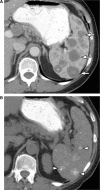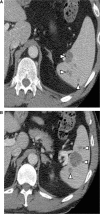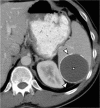Primary and secondary neoplasms of the spleen
- PMID: 20713317
- PMCID: PMC2943678
- DOI: 10.1102/1470-7330.2010.0026
Primary and secondary neoplasms of the spleen
Abstract
With the exception of lymphoma involving the spleen, other primary and secondary neoplasms are rare and infrequently encountered. Primary malignant neoplasms involving the spleen are lymphoma and angiosarcoma. Primary benign neoplasms involving the spleen include hemangioma, lymphangioma, littoral cell angioma and splenic cyst and solid lesions such as hamartoma and inflammatory pseudotumor.
Figures
















References
-
- Dachman A. Radiology of the spleen. St. Louis, MO: Mosby; 1993.
-
- Kamaya A, Weinstein S, Desser TS. Multiple lesions of the spleen: differential diagnosis of cystic and solid lesions. Semin Ultrasound CT MR. 2006;27:389–403. doi:10.1053/j.sult.2006.06.004. - DOI - PubMed
-
- Spier CM, Kjeldsberg CR, Eyre HJ, Behm FG. Malignant lymphoma with primary presentation in the spleen. A study of 20 patients. Arch Pathol Lab Med. 1985;109:1076–80. - PubMed
-
- Bhatia K, Sahdev A, Reznek RH. Lymphoma of the spleen. Semin Ultrasound CT MR. 2007;28:12–20. doi:10.1053/j.sult.2006.10.010. - DOI - PubMed
-
- Ahmann DL, Kiely JM, Harrison EG, Jr, Payne WS. Malignant lymphoma of the spleen. A review of 49 cases in which the diagnosis was made at splenectomy. Cancer. 1966;19:461–9. doi:10.1002/1097-0142(196604)19:4<461::AID-CNCR2820190402>3.0.CO;2-X. - DOI - PubMed
Publication types
MeSH terms
LinkOut - more resources
Full Text Sources
Medical
